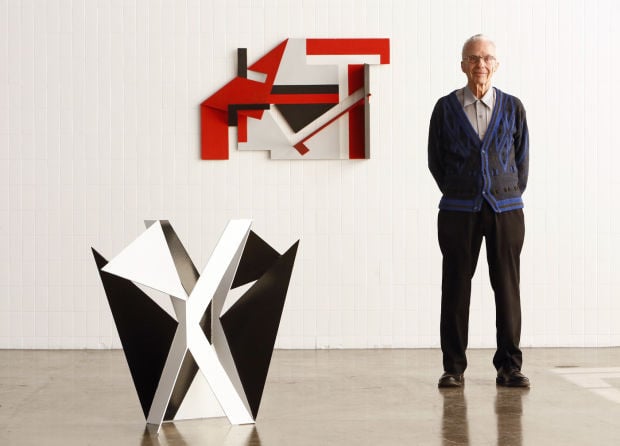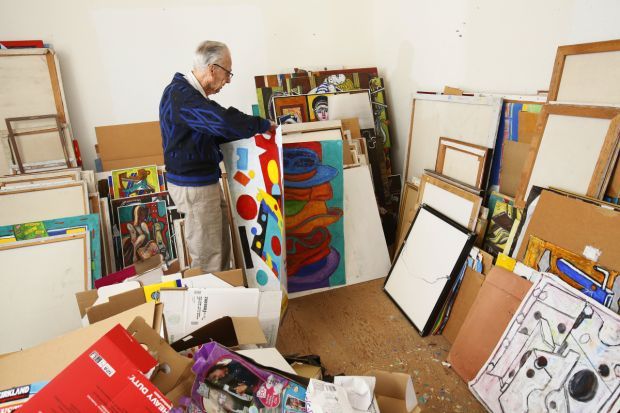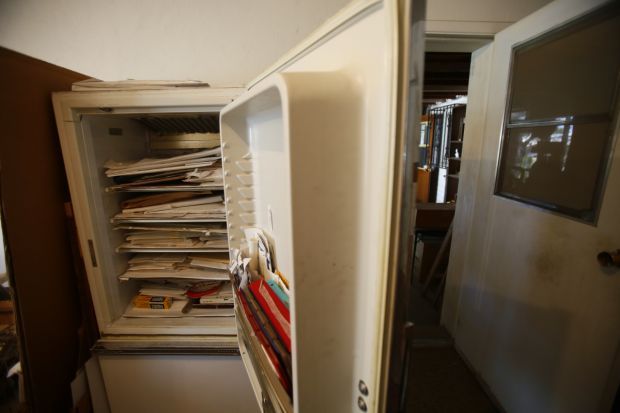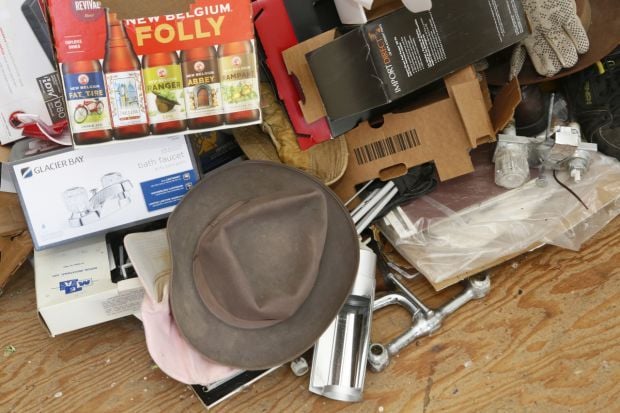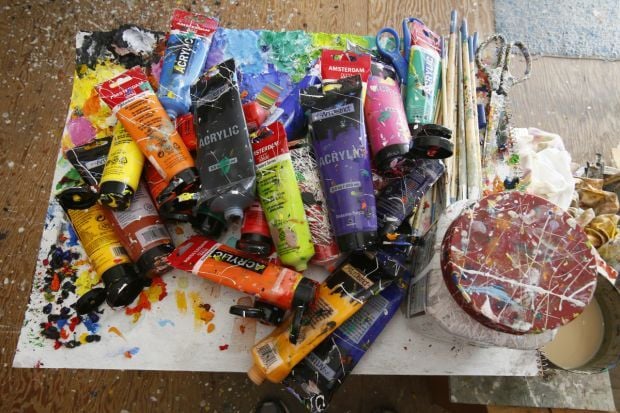Robert Barber has always loved to paint.
It’s why he studied it. Why he taught it for some 30 years. And why he does it every day.
Still, success as an artist eluded him.
Until now.
At 92 (“92½,” he proudly says), the Tucsonan has been discovered.
In a big way.
The Museum of Contemporary Art Tucson has turned over its massive space to Barber’s works, which span more than 60 years.
Next month, he will be honored at MOCA’s annual gala.
And at least one New York City gallery is clamoring to exhibit his works.
The discovery
Back in 2013, MOCA’s executive director and chief curator Anne-Marie Russell and curator Jocko Weyland, were at the Tucson Museum of Art Biennial when their eyes were drawn to two bright yellow paintings.
“They were so exquisite,” recalls Russell. “What was striking was the quality of the paintings. I looked at them, at the label, and saw he was from Tucson. Then I saw his birth date and realized he was 92. At the same time, Jocko stopped in his tracks. We were so excited.”
Neither Weyland nor Russell were familiar with Barber’s name, and the first thought was that he was an Outside Artist — the term given to self-taught artists who are out of the mainstream.
Then they looked more closely.
“We saw how well the paint was handled,” says Weyland. “You could tell he knew how to paint.”
“It was the quality of the painting,” adds Russell. “To see that level of quality and sophistication — the skill was really stunning. The only thing he was outside of was the marketplace.”
They weren’t sure if the paintings in the show were a fluke or if there were more stunners like the ones they saw.
“I could learn nothing about him online and had seen only the two paintings,” says Weyland.
Still, those paintings were strong enough to push them to contact Barber and visit him at his home studio.
“Right away, you see it’s a special place,” says Weyland.
“We went to the door and (it was answered by) this unassuming man, friendly and gracious.” And surprised that they were interested in his work.
When he first entered the house, Weyland spotted a small watercolor on the living room wall. It was a Southwestern scene that “was so beautiful it totally transcended the genre of a southwest landscape.” They moved through rooms packed with works by Barber and his late wife, Fern, who was also an artist.
“We talked for awhile, looked around and saw art on his walls, but in no way did that prepare us for his studio. It was shocking — just the quantity — and that was a quarter of what was there.”
They went through the dusty canvases stacked up against a wall. And at his cardboard sculptures, some of which sit in his yard and have not stood up to the elements.
“Because his work was never really bought, it’s all there, it’s his whole life, and it’s astounding what he’s done,” says Weyland.
They left after a few hours with plans to return.
“We were both reeling from what we saw,” says Weyland. “As we drove away, we knew we had encountered something extraordinary.”
The early years
Minneapolis-born Barber can’t remember a time he didn’t love to draw.
“I’ve made art all my life,” he says. “I have drawings I made when I was 11 — I had copied (Norman) Rockwell.”
In high school — where he was a champion wrestler and won a national title — he snagged a scholarship to attend a summer art school.
“I had to draw naked women for two months,” he recalls. “I had never even seen a picture of a naked woman. I tried to concentrate.”
He was just 20 when he interrupted college to join the Navy, serving a four-year stint during World War II. Even then, he didn’t forsake his art: he drew cartoons for the ship’s paper. Post-war, he was back to school, where he studied to be a commercial artist. Then a teacher took him to see Matisse’s “Boy with Butterfly Net.”
“I thought, why would I want to paint spark plugs when I can be liberated by paint?” he says.
He met Fern at art school in 1946 and the two married in ’48. “She thought I was Picasso, I thought she was Matisse,” Barber says. The two had been married 65 years when she passed away five years ago, and her presence is still palpable in the house, where her studio remains pristine.
Barber received his undergraduate degree at the Minneapolis School of Art (now the Minneapolis School of Art & Design) and his masters in fine art from the University of Minnesota. A few years after graduation, he and his wife packed and moved to Bloomington, where he taught art at the University of Wesleyan.
But three years later, in 1956, his wife’s arthritis was crippling and she needed out of the cold. Tucson was the place to be.
The University of Arizona wasn’t hiring. So he supported his wife and two children with odd jobs, working in a warehouse, and doing commercial art and teaching art.
“It was hard,” he says about the struggle to make ends meet.
“We made furniture out of cardboard. I still have some of the pieces.”
Then one day he opened a newspaper and saw the Tucson Unified School District needed teachers.
“I had two degrees, so I went to the UA to find out what I had to do to get a teaching certificate. I did courses by correspondence and did a year’s worth of coursework in one quarter.”
That TUSD job teaching art lasted 30 years and took him through to retirement.
And it allowed him the time to paint.
“The nice thing about teaching is we got three months vacation and I would paint then,” he says. “And whenever else I could find time.”
Making art
Barber has lived in the same house since the family moved here in ’56. The cozy, mid-town home is a testament to his wife’s figurative works — drawings and paintings of dancers and portraits hang on walls.
“I remember from the earliest age both my parents painting,” says Barber’s son, Brian, an engineer living in Northern California. “They were great supporters of each other’s art.”
Brian doesn’t remember when his father wasn’t painting, and the house has the signs of it — from the paint-covered doorknobs to the second floor studio where Barber still spends at least two to three hours a day painting. That sunny studio has piles of beer cartons he has salvaged from a nearby garbage dump, a variety of hats, a box full of tossed-aside works, a little table with acrylics and crayons and paint-splattered scissors, and a small cardboard sculpture, a model for a painting he was working on. Cardboard is an easy, inexpensive canvas for him, and he loves the colors in the beer cartons.
He and Fern often participated in exhibits.
“But Fern’s was more salable than mine,” says Barber. “They bought her’s but wouldn’t look at mine. I would get so excited for her.”
It may not have sold, but Barber stuck to his style, which was most often abstract.
“I’ve had shows where they said ‘you’re no artist’,” he says about reactions to his work.
Still, he wasn’t discouraged. “All you can do is rely on yourself,” he says.
He continued to make art.
“Some guys golf, I paint,” he explains, matter-of-factly. “It’s like breathing to me.”
He didn’t long for the fame and money some artists might.
“I’ve never cared if I sold a painting,” he says. “I’ve never had to satisfy a dealer; I have had the freedom to do what I’ve wanted.”
Barber’s imagination is sparked by the beer cartons he salvages, letters, numbers, and even the underpinnings of a freeway. In the early ’70s, the family took a trip to San Francisco where the children attended a dance school. While they were in class “I would run under the freeways and make drawings,” says Barber.
Serial works
While the quality of his works is steady, his style is not. In addition to sculpture and abstract paintings, he has a group of narrative paintings, works that explode in color, others in just black and white. He has a tendency to do groups of paintings or sculptures all based on the initial inspiration. “I do a series until I get tired of it, and that is that,” says Barber. “I don’t want to feel compartmentalized.”
At MOCA, the Great Hall houses the series of works based on the California freeways that sparked his imagination that summer. In a nearby case are drawings on 6-inch pieces of scrap paper — the studies for the paintings on the walls. “If not for my wife, these would not exist,” says Barber pointing to the studies. “She would carefully wrap and save each one.”
In the same hall at MOCA are large abstract expressionist pieces with big, bold strokes and gorgeous blues and greens and reds. Another series is based on mountains with precise lines giving way to soft shapes. He has a series of abstract cardboard sculptures based on the letters T and X and the number 7. Another glass case in that main gallery is filled with maquettes — small-scale models for the sculptures.
Move into the smaller galleries of the museum and you’ll find a few rooms with his very early works, where his influences such as Matisse and Gorky can be seen, as well as the works where Barber burst out with his own style. He’s created Pop works, collages, figurative works — there is no way Barber could be compartmentalized.
His most important work
Barber loves painting. But it is secondary to the role he has played as father and husband.
“He’s the kindest, gentlest, most humble man,” says his daughter, Tucsonan Leigh Anne Barber.
“He’s the greatest dad on earth,” says his son Brian. “He’s always been there for us. Always. And he was a great husband to our mother.”
After living with and loving their father’s art (and sometimes destroying it; Brian remembers using the paintings for a wall for a fort, which did not sit well with their mother, who stressed that one day the works would be valuable), the two Barber children are deliriously happy for the attention he is getting.
Leigh Ann remembers her father calling her and saying, “You’ll never believe what happened — I got into the Biennial.” Not long after, he called again. “You’ll never believe what happened,” he said as he told her about MOCA’s interest in his work.
“I’m so happy for him,” she says, tears in her eyes. “It’s a little like a dream — the most wonderful dream.”
Contact reporter Kathleen Allen at kallen@tucson.com or 573-4128.


